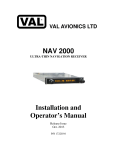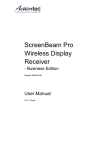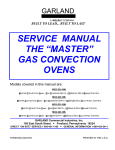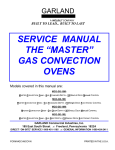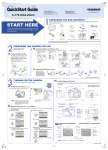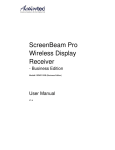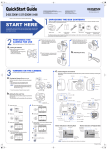Download VAL Avionics INS 422 Operator`s manual
Transcript
VAL AVIONICS LTD INS 429 INTEGRATED NAVIGATION SYSTEM Installation and Operator’s Manual Original Issue August 2008 P/N 1720101 V A L A V I O N I C S L T D I N S 4 2 9 I N T E G R A T E D N A V I G A T I O N S Y S T E M I N S T A L L A T I O N A N D O P E R A T O R ’ S M A N U A L This Page Intentionally Left Blank Original Issue August 2008 Page 2 of 21 V A L A V I O N I C S L T D I N S 4 2 9 I N T E G R A T E D N A V I G A T I O N S Y S T E M I N S T A L L A T I O N A N D O P E R A T O R ’ S M A N U A L Table of Contents 1 2 3 4 5 6 7 SECTION I - GENERAL INFORMATION.......................................................................................4 1.1 INTRODUCTION............................................................................................................................ 4 1.2 SCOPE ............................................................................................................................................. 4 1.3 EQUIPMENT DESCRIPTION........................................................................................................ 4 1.4 SPECIFICATIONS .......................................................................................................................... 5 1.5 EQUIPMENT SUPPLIED ............................................................................................................... 6 1.6 EQUIPMENT REQUIRED BUT NOT SUPPLIED ........................................................................ 6 1.7 LICENSE REQUIREMENTS.......................................................................................................... 6 SECTION II - INSTALLATION .........................................................................................................7 2.1 GENERAL INFORMATION .......................................................................................................... 7 2.1.1 Scope ...................................................................................................................................... 7 2.2 UNPACKING AND INSPECTION ................................................................................................ 7 2.3 EQUIPMENT INSTALLATION PROCEDURES.......................................................................... 7 2.3.1 Cooling Requirements ............................................................................................................ 7 2.3.2 Mounting Requirements ......................................................................................................... 7 2.3.3 Wire Harness Fabrication ....................................................................................................... 8 2.3.4 INS 429 Installation................................................................................................................ 8 2.4 POST INSTALLATION CHECK.................................................................................................... 9 2.4.1 Operational Check .................................................................................................................. 9 2.4.2 Final Inspection ...................................................................................................................... 9 2.5 LIMITATIONS ................................................................................................................................ 9 SECTION III - OPERATION ............................................................................................................10 3.1 GENERAL INFORMATION ........................................................................................................ 10 3.1.1 Scope .................................................................................................................................... 10 3.1.2 Display Functions ................................................................................................................. 10 3.1.3 User Controls........................................................................................................................ 11 3.2 System Configuration..................................................................................................................... 12 3.2.1 Accessing Setup Functions ................................................................................................... 12 SECTION IV - WARRANTY AND SERVICE ................................................................................14 4.1 LIMITED WARRANTY ............................................................................................................... 14 4.2 SERVICE ....................................................................................................................................... 14 Appendix A – INSTALLATION DRAWINGS AND CONNECTOR LAYOUT ..........................15 Appendix B – WIRING DIAGRAMS................................................................................................18 Appendix C – INSTRUCTIONS FOR CONTINUED AIRWORTHINESS ..................................21 7.1 MAINTENANCE INSTRUCTIONS............................................................................................. 21 Table 1: Table 2: Table 3: Table 4: Specifications .................................................................................................................................. 5 Equipment Supplied ........................................................................................................................ 6 Equipment Not Supplied ................................................................................................................. 6 Rear Connector Pin Functions....................................................................................................... 17 Figure 1: Unit Controls................................................................................................................................ 10 Figure 2: Physical Dimensions .................................................................................................................... 15 Figure 3: P1 Connector Pin Out .................................................................................................................. 15 Figure 4: Panel Cut Out............................................................................................................................... 16 Figure 5: INS 429 Basic Wiring Diagram .................................................................................................... 18 Figure 6: Interface with AP100 .................................................................................................................... 18 Figure 7: Autopilot Connection Diagram .................................................................................................... 19 Figure 8: External Input Connection Diagram ............................................................................................ 19 Original Issue August 2008 Page 3 of 21 V A L A V I O N I C S L T D I N S 4 2 9 I N T E G R A T E D N A V I G A T I O N S Y S T E M I N S T A L L A T I O N A N D O P E R A T O R ’ S M A N U A L 1 SECTION I - GENERAL INFORMATION 1.1 INTRODUCTION Thank you for purchacing our INS 429 Integrated Navigation System. Here at Val Avionics Ltd., our core design philosophy is based on the ease of installation and use. The 429 represents 5 years of refinement in that process, based on the feedback of customers that have used the INS 422. The INS 429 is a totally new concept, designed with new and exciting features. That design philosophy translates into the ease of installation and simple operation makes the INS 429 Integrated Navigation System a navigation solution for a wide variety of aircraft panels, from the Homebuilt through heavy twins. The INS 429 satisfies the need for compact, fully intergraded, quality navigational aid that can be counted on to provide years of reliable service. Before installing and /or using your new INS 429 please read this manual completely. This will ensure proper installation and familiarize you with all of the features your NAV has to offer. 1.2 SCOPE This manual will provide detailed information about the installation and operation of the INS 429 Integrated Navigation System. It will also provide equipment limitation information and instructions for continued airworthiness. 1.3 EQUIPMENT DESCRIPTION The INS 429 has been designed for simplicity. It is straight forward to install and operate. Using state of the art technology Val Avionics Ltd. has created a navigation instrument that will provide the pilot with simple easy to interpret navigation information for in-route VOR and ILS Approach. The INS 429 can also be coupled to an external GPS system and display the GPS course deviation. The INS 429 also has an enhanced display that features both active and standby frequency displays. A display that shows the pilot the type of station that is selected as active, be it a VOR or an ILS. Also continually displayed is the selected radial. Other display features include a three light marker and a back course indicator. The course deviation indicators are displayed as a dot matrix array that is easily interpreted by the flight crew. The display incorporates the latest is high intensity LED technology which provides excellent view ability even in direct sunlight. The unit’s controls have been designed for simple user interface. The concentric knobs on the left side of the unit select the standby frequency with a push button flip-flop to load the standby frequency into the active window. The concentric knobs on the right side of the unit select the desired radial. The push button on the right side knob set lets the user flip-flop the selected radial 180°. A long push of the right button will produce the centered radial from the selected station. The INS 429 has three internal receivers. The VOR/LOC receiver operating from 108.00 MHz to 117.95 MHz, the Glide Slope receiver which operates from 329.15 MHz to 335.0 MHz, and the Marker receiver operating at 75 MHz. The INS 429 also has an external mode. The external mode is selected as a frequency as described above. In external mode the INS 429 can be used as a standard NAV Indicator and coupled to an external NAV or GPS receiver via the rear connector. Original Issue August 2008 Page 4 of 21 V A L A V I O N I C S L T D I N S 4 2 9 I N T E G R A T E D N A V I G A T I O N S Y S T E M I N S T A L L A T I O N A N D O P E R A T O R ’ S M A N U A L 1.4 SPECIFICATIONS Table 1: Specifications SPECIFICATIONS CHARACTERISTICS Environmental: (RTCA/DO160D) VOR Localizer Glide slope Marker Beacon RTCA/DO-196 RTCA/DO-195 RTCA/DO-192 RTCA/DO-143 Class B Physical Dimensions: Height Width Depth 3.40 inches (8.64 cm) 3.45 inches (8.76 cm) 9.87 inches (25.07 cm) Weight: 3.25 pounds (1.5 kg) Mounting: Panel mounted, no shock mounting required Temperature Range: -20 to +55 Celsius with short time operations at +70 Celsius Power Requirements: Voltage Current 11.0 to 30.0 VDC 0.75 Amp @ 14V, 0.40 Amp @ 28V Receiver: VHF Frequency (VOR/LOC) Sensitivity Channel Spacing (VOR/LOC) UHF Frequency (Glide slope) Sensitivity Channel Spacing (Glide slope) 108.00 to 117.95 MHz 2 µV to provide 50% Standard Deflection 50 KHz 329.15 to 335.0 MHz 20 µV to provide 50% Standard Deflection 150 KHz Marker Receiver AGC Characteristics 75 MHz From 10 µV to 200 µV the audio level will not vary more than 3db. External Outputs: Audio Output CDI Left/Right CDI Up/Down CDI Glide slope Flag CDI VOR/LOC Flag 10mv into a 600 ohm load 150mv into 1K Load 150mv into 1K Load 250mv into 1K Load 250mv into 1K Load External Inputs CDI Left/Right CDI Up/Down CDI Glide slope Flag 150mv into 1K Load 150mv into 1K Load 250mv into 1K Load Manufacturer’s Model Number Part Number INS 429 VPN 0800101-1 Original Issue August 2008 Page 5 of 21 V A L A V I O N I C S L T D I N S 4 2 9 I N T E G R A T E D N A V I G A T I O N S Y S T E M I N S T A L L A T I O N A N D O P E R A T O R ’ S M A N U A L 1.5 EQUIPMENT SUPPLIED Table 2: Equipment Supplied QTY DESCRIPTION 1 INS 429 INTEGRATED NAVIGATION SYSTEM 1 INSTALLATION KIT 1.6 EQUIPMENT REQUIRED BUT NOT SUPPLIED Table 3: Equipment Not Supplied QTY DESCRIPTION 1 Interconnect Wire Harness 1 Headphone Jacks 1.7 PART NUMBER 0800101 0650103 1 Circuit Breaker 2 amp 1 Aircraft Cabin Speaker 1 Contact Crimping Tool w/ Positioning Tool PART NUMBER VPN 0751030 or field fabricated Switchcraft P/N 11 (Ref VPN 550017) Potter & Brumsfield W58-2 (Ref VPN 0331005) Ref aircraft parts manual for specific part number AMP P/N 601966-1 AMP P/N 601699-5 LICENSE REQUIREMENTS None Original Issue August 2008 Page 6 of 21 V A L A V I O N I C S L T D I N S 4 2 9 I N T E G R A T E D N A V I G A T I O N S Y S T E M I N S T A L L A T I O N A N D O P E R A T O R ’ S M A N U A L 2 SECTION II - INSTALLATION 2.1 GENERAL INFORMATION 2.1.1 Scope This section of the manual will provide the needed information to successfully complete the installation of your new INS 429 Integrated Navigation System. Please read this section completely before proceeding with the installation process. Although the INS 429 installation procedures are designed with the do-ityourselfer in mind, we at Val Avionics Ltd. strongly suggest that you seek the advice of a qualified avionics installation facility before beginning this or any other installation project. Qualified avionics installation technicians can offer good advice as to time-tested installation practices and techniques that can save you many hours of time and frustration. 2.2 UNPACKING AND INSPECTION Use care when unpacking the equipment. Inspect the unit and supplied parts for visual signs of damage during shipment. Examine the unit for loose screws, dents, broken buttons and other signs of damage that may have occurred during shipment. Verify the contents of the container with the list in section 1.5. If any damaged or missing parts are discovered during the inspection save the shipping material and contact the freight carrier to file a claim. If it is suspected that parts were omitted from the container please feel free to contact Val Avionics Ltd., to acquire the missing items. 2.3 EQUIPMENT INSTALLATION PROCEDURES 2.3.1 Cooling Requirements Forced air-cooling is not required for the INS 429 Integrated Navigation System. However, when planning the location for mounting, ensure adequate spacing from heat producing sources such as heating or defrosting ducts. 2.3.2 Mounting Requirements The INS 429 Integrated Navigation System should be rigidly mounted in the instrument panel using the hardware provided in the installation kit. Ensure that the mounting location will provide easy access and a clear view of the equipment’s front panel from the pilot’s position. Ensure that the mounting position will provide adequate clearance between the unit and the associated wire harness and the aircraft controls. Bracing at the rear of the unit should be installed to ensure rigidity in the panel. Consult FAA Advisory Circular AC 43.13-2A for acceptable practices and techniques. Original Issue August 2008 Page 7 of 21 V A L A V I O N I C S L T D I N S 4 2 9 I N T E G R A T E D N A V I G A T I O N S Y S T E M I N S T A L L A T I O N A N D O P E R A T O R ’ S M A N U A L 2.3.3 Wire Harness Fabrication Val Avionics Ltd. recommends that a factory fabricated wire harness (VPN 0751030) be used for the installation of the INS 429 Integrated Navigation System. Use of the factory fabricated wire harness will ensure proper operation of the INS 429, reduction in the occurrence of interfering signals and ground loops, greatly reduced installation time, and provide prolonged trouble-free performance of your new equipment. Contact Val Avionics Ltd. or your local avionics distribution center for INS 429 Wire Harness ordering information. Although strongly recommended, it is not required to use the factory fabricated wire harness when installing the INS 429. A wiring harness can be fabricated in the field. Refer to appendix B of this manual for a complete wiring diagram. The INS 429 is connected to the aircrafts avionics bus via a 3 AMP circuit breaker. All wires must be 22 AWG MIL-SPEC, unless otherwise noted in accordance with current regulations. Two and three conductor shielded MIL-C-27500 or equivalent wire must be used where indicated. Use AMP Contact Crimping Tool (AMP P/N 601966-1) with Positioning Tool (AMP P/N 601699-5) or equivalent to ensure good quality contacts. Refer to FAA Advisory Circular AC 43.13-2A for acceptable practices and techniques. 2.3.4 INS 429 Installation 2.3.4.1 Mounting The INS 429 is rigidly mounted in a standard 3.125” round cutout on the aircraft panel. Once a location has been selected, a visual inspection should be made of the area directly behind the panel which, will be occupied by the INS 429 and harness assembly for obvious obstructions such as heater ducts, control cables, fuel and oil lines or any other obstruction. Pay particular attention to the control yoke assembly. It should be moved to the full limit of travel and verified that sufficient clearance exists prior to beginning installation. Most aircraft instrument panels will already have existing instrument mounting cutouts. If the location you have selected requires that a mounting hold be cut, refer to Figure 4: Panel Cut Out on Page 16 for the mounting template. Mark and cut the mounting holes as required. Position the unit in its upright position, and from the rear of the panel, place the unit into the selected 3.125” panel cutout. With the unit held in place, insert four of the supplied 6-32 X 3/8” screws from the front and tighten as appropriate. The installing agency must fabricate and attach rear support brackets to the aircraft structure behind instrument panel as appropriate to support the rear of the INS 429. Then, attach these brackets to the provided attachment points on the rear of the unit with the supplied 6-32 3/8" Screws. 2.3.4.2 Antennas Two antennas are required for the INS 429 installation. A standard VOR/Glide Slope antenna can be used with the unit such as a COMANT CI-157 or equivalent. The most common location for the antenna is on top of the vertical stabilizer. The VOR/Glide Slope antenna can be coupled to the unit’s NAV and G/S antenna ports via an antenna coupler such as a COMANT CI-205 or equivalent coupler. The recommended marker antenna is a COMANT CI-201 or equivalent mounted on the bottom of the aircraft and coupled to the MKR antenna port of the unit. Original Issue August 2008 Page 8 of 21 V A L A V I O N I C S L T D I N S 4 2 9 I N T E G R A T E D N A V I G A T I O N S Y S T E M I N S T A L L A T I O N A N D O P E R A T O R ’ S M A N U A L 2.3.4.3 Audio The INS 429 has two audio outputs, Navigation audio and Marker audio. Although the audio output levels of the receivers are capable of driving a standard headset directly, it is strongly recommended that these audios be coupled to a quality audio selector panel such as a Val Avionics AP 100. For complete details, refer to the interconnect wiring diagrams in Appendix B. 2.4 POST INSTALLATION CHECK 2.4.1 Operational Check Refer to section three of this manual. Using a calibrated VOR, Localizer, Glide Slope and Marker signals, check all functions of the INS 429 for proper operation. Check the operational functions of other equipment installed in the aircraft in accordance with the individual manufacture’s operation manuals to insure that no cross interference exists as a result of this installation. 2.4.2 Final Inspection Verify that the wiring is bundled away from all controls and that no part of the installation interferes with the movement of the aircraft controls. Move all of the aircraft controls through their full range of movement while visually verifying that the installation does not mechanically interfere with the control movement. Verify that the wiring harnesses are properly secured to the aircraft structure in accordance with accepted practices as described in AC 43.13 and that adequate strain relief and service loops have been provided. Ensure that there are no kinks or sharp bends in the wire harnesses. Verify that the wire bundles are not exposed to any sharp or abrasive surfaces. Complete log book entries, FAA form 337, weight and balance computations and other documentations as required. 2.5 LIMITATIONS There are no known limitations to the operation of the INS 429. Instructions for Continued Airworthiness and Return to Service Instructions can be found in Appendix C. Original Issue August 2008 Page 9 of 21 V A L A V I O N I C S L T D I N S 4 2 9 I N T E G R A T E D N A V I G A T I O N S Y S T E M I N S T A L L A T I O N A N D O P E R A T O R ’ S M A N U A L 3 SECTION III - OPERATION 3.1 GENERAL INFORMATION 3.1.1 Scope This section will provide detailed operating instructions for your new INS 429 Integrated Navigation System. Please read this section completely to become familiar with all of the features of the unit. Mode Display Bearing Display Active Frequency Status Display Standby Frequency Marker Lights Active - Standby Swap (Push) / On-Off (Push & Hold) To - From Swap, Mkr Mute (Push)/ Auto Radial Center (Push & Hold) Frequency Select (kHz) Bearing Select (x1º) Frequency Select (MHz) Bearing Select (x10º) Figure 1: Unit Controls 3.1.2 Display Functions The Mode display will change automatically in conjunction with the frequency that is loaded into the active frequency position. “VOR” will appear if a VOR frequency is loaded and “ILS” will appear if an ILS frequency is loaded. When “EXT” is loaded in the active position, the mode display will display “XVOR”, “XILS” or “XGPS” depending on the type of device that is connected to the external inputs at the rear connector of the INS 429. The Bearing and Status displays are contained in the upper right quadrant of the INS 429. The bearing (or radial) will be displayed at all times in the top (Bearing) display and either “TO”, “FROM”, or “BKCS” in the lower (Status) display. If the unit is not receiving a valid VOR signal the lower display will be blank and the CDI display will be flagged. The unit displays a flagged condition by showing full deflection of dots in both directions. In the case of a horizontal flag (VOR / Localizer), the CDI will show a horizontal bar indicating a flag. In the case of a vertical flag (Glide Slope), the VDI will show a vertical bar indicating a flag. The marker receiver is always operational and the marker lights are located horizontally in the lower right quadrant of the unit’s display. Original Issue August 2008 Page 10 of 21 V A L A V I O N I C S L T D I N S 4 2 9 I N T E G R A T E D N A V I G A T I O N S Y S T E M I N S T A L L A T I O N A N D O P E R A T O R ’ S M A N U A L 3.1.3 User Controls Refer to Figure 1: Unit Controls. The user controls consist of two sets of concentric rotary knobs. The set on the left control functions on the left side of the display and the set on the right control the functions on the right side of the display. Both sets of knobs contain three parts, the inner knob (the small one) the outer knob (the large one) and a momentary push button (the end of the small knob). 3.1.3.1 Turning the unit on/off To turn the unit on, momentarily press the left hand inner knob. The unit will go through a short initialization routine at start up and then begin operation at the same settings that were loaded at the last power down. To turn the unit off, press and hold the left inner knob for three seconds. 3.1.3.2 Setting Active and Standby Frequency The knob functions of the left hand set are as follow; the inner knob will change the frequency by KHz or the numbers to the right of the decimal point (108.15) in 50kHz increments. The outer knob will change the frequency by MHz or the numbers to the left of the decimal point (108.15) in 1 MHz increments. Only the frequency in the standby position will change. The standby frequency is displayed at the bottom on the left side of the display and is identified by the letter “S” to the left of the frequency (S108.15). To load the standby frequency in to the active position, momentarily press on the inner knob. This will swap the standby frequency with the active frequency. The active frequency is identified by the letter “A” at the left of the frequency display (A108.15). If the external inputs are active (configured in the setup pages see section 3.2.1.3 on pg. 13) “EXT” will appear in the standby frequency position while rotating the outer knob. “EXT” is located between “117.XX” and “108.XX”. ”EXT” stands for external as in external function. “EXT” can be loaded into the active display position by momentarily pressing on the inner knob. When “EXT” is loaded into the action position the INS 429 will display CDI and VDI information from an external receiver source such as an external GPS or an external NAV. 3.1.3.3 Setting a Bearing The knob functions on the right side of the unit are as follow; the inner knob changes the bearing display by 1° increments. The outer knob changes the bearing display by 10° increments. 3.1.3.4 To/From Swap and Auto Radial Centering When “VOR” is displayed in the mode display, momentarily pressing the inner right knob will change the displayed bearing to the 180° reciprocal. Pressing and holding the inner knob for three seconds will change the bearing to the centered “FROM” radial of the received VOR station. Original Issue August 2008 Page 11 of 21 V A L A V I O N I C S L T D I N S 4 2 9 I N T E G R A T E D N A V I G A T I O N S Y S T E M I N S T A L L A T I O N A N D O P E R A T O R ’ S M A N U A L 3.1.3.5 Selecting the Backcourse When ILS is displayed in the mode display pressing and holding the right inner knob for three seconds will enable the ILS in the back course mode and “BKCS” will be displayed in the Status display. While in the back course mode the glide slope VDI display will be flagged. Pressing and holding the right inner knob again for three seconds will return the ILS to the standard display mode. 3.1.3.6 Changing the Volume The receiver’s audio volume is controlled by momentarily pressing both of the inner knobs at the same time. “VOL” will be displayed in the standby frequency display and the volume level is indicated by the numeric value after “VOL” (i.e. “VOL 15”). The volume level can be adjusted from 0 to 20 by rotating the left hand large knob. Normal display operation resumes after 5 seconds or by pushing both knobs at the same time. 3.1.3.7 Marker Mute When the unit is selected to an ILS frequency and is displaying “ILS”, the marker receiver’s audio can be muted for 1 minute by momentarily pressing the right button. This does not function on VOR frequencies. 3.2 System Configuration 3.2.1 Accessing Setup Functions During startup, the unit’s setup can be assessed by pressing both buttons simultaneously until the unit’s Mode display shows “CONF”. In this mode, the marker volume, marker mix, and external interface enable can be configured. To select each individual setting, rotate the right outer knob until the Active Frequency display and Standby Frequency display show the desired setting. To exit this mode and resume normal operation, press both buttons simultaneously. 3.2.1.1 Marker Volume When the Active Frequency display shows “Marker”, and the Standby shows “Vol”, the marker volume can be adjusted by rotating the right inner knob. The settings range between 5 and 20 in accordance with FAA regulation. 3.2.1.2 Marker Mix When the Active Frequency display shows “Marker”, and the Standby shows “Mix”, the marker mix function can be turned on and off. This function allows for the VOR/Localizer audio output (Pin 33) to also contain the Marker audio signal. “On” mixes the audio onto that one line, “Off” separates the audio to their separate lines as indicated on the wiring diagram. Original Issue August 2008 Page 12 of 21 V A L A V I O N I C S L T D I N S 4 2 9 I N T E G R A T E D N A V I G A T I O N S Y S T E M I N S T A L L A T I O N A N D O P E R A T O R ’ S M A N U A L 3.2.1.3 External Mode When the Active Frequency display shows “Extern”, and the Standby shows “Mode”, the external mode function can be turned selected. When this function is “Off”, the frequency selection will rollover from 117 MHz to 108 MHz with no “Ext” shown in the frequency display. This setting is typical for an installation that does not utilize the External Navigation inputs. “Anl” selects the analog inputs and enables the “Ext” selection in the frequency display. Original Issue August 2008 Page 13 of 21 V A L A V I O N I C S L T D I N S 4 2 9 I N T E G R A T E D N A V I G A T I O N S Y S T E M I N S T A L L A T I O N A N D O P E R A T O R ’ S M A N U A L 4 SECTION IV - WARRANTY AND SERVICE 4.1 LIMITED WARRANTY The equipment delivered with this Standard Factory Warranty is manufactured by Val Avionics, Ltd. and is guaranteed against defective materials and workmanship for one year from date of original retail purchase. Any unit found to be defective due to material and workmanship during the warranty period will be repaired or replaced at the sole discretion of Val Avionics Ltd. Val Avionics, LTD liability under this warranty is limited to servicing, repairing or adjusting any equipment returned prepaid to the Val Avionics’ factory by express written or verbal authorization for that purpose and to repair or replace defective parts thereof. If, upon examination, it is determined that a malfunction has been caused by misuse of the equipment, installation or operation not in accordance with factory instructions, accident or negligent damage, alterations of any manner, and repair by other than the factory, the repairs will not be covered under the warranty. In such cases, an estimate will be submitted for approval before repair is initiated. In most cases, Val avionics, Ltd. will provide 72-hour turn around on its warranty and repair service. We recommend that contact be made with the FACTORY CUSTOMER SERVICE DEPARTMENT prior to any unit return and obtain RETURN AUTHORIZATION AND INSTRUCTIONS. This will provide proper control and expedite service. Val Avionics, Ltd. reserves the right of continuous product development without obligation to install changes in previously manufactured products. Installation of Val Avionics, Ltd. products must conform to methods acceptable by the Federal Aviation Administration as described in the appropriate Federal Aviation Regulations (FAR’s) and Advisory Circulars (AC’s). To ensure proper warranty registration, type or print clearly the application information on the enclosed PRODUCTS WARRANTY REGISTRATION FORM and return to Val Avionics, Ltd. 4.2 SERVICE Repair service for the INS 429 Integrated Navigation System is available at our manufacturing facility. Units in need of servicing should be returned prepaid to Val Avionics Ltd at the following addresses. If you are shipping by the US Postal Service address To: Val Avionics P.O. Box 13025 Salem, OR 97309 If you are shipping by FedEx, UPS or other shipping company, address to: Val Avionics 3280 25th ST SE Salem, OR 97302 Original Issue August 2008 Page 14 of 21 V A L A V I O N I C S L T D I N S 4 2 9 I N T E G R A T E D N A V I G A T I O N S Y S T E M I N S T A L L A T I O N A N D O P E R A T O R ’ S M A N U A L 5 Appendix A – INSTALLATION DRAWINGS AND CONNECTOR LAYOUT Figure 2: Physical Dimensions Figure 3: P1 Connector Pin Out Original Issue August 2008 Page 15 of 21 V A L A V I O N I C S L T D I N S 4 2 9 I N T E G R A T E D N A V I G A T I O N S Y S T E M I N S T A L L A T I O N A N D O P E R A T O R ’ S M A N U A L (Drawing Not to Scale) Figure 4: Panel Cut Out Original Issue August 2008 Page 16 of 21 V A L A V I O N I C S L T D I N S 4 2 9 I N T E G R A T E D N A V I G A T I O N S Y S T E M I N S T A L L A T I O N A N D O P E R A T O R ’ S M A N U A L Table 4: Rear Connector Pin Functions Pin Original Issue August 2008 Functoin 1 Main Power 2 Airframe Ground 3 External CDI +Left 4 External CDI +Flag 5 External VDI +Up 6 External VDI +Flag 7 External ILS Energize 8 External From Flag 9 External GPS Annunceator 10 Resolver Sin Output 11 Autopilot +Down 12 Autopilot +Left 13 Autopilot CDI +Flag 14 ILS Energize 15 Audio Output Marker 16 Future Expantion (Not Used) 17 Not Used 18 Not Used 19 Not Used 20 Main Power 21 Airframe Ground 22 External CDI +Right 23 External CDI -Flag 24 External VDI +Down 25 External VDI -Flag 26 External To Flag 27 External VLOC Annunceator 28 Resolver Referance 29 Resolver Cos Output 30 Autopilot +Up 31 Autopilot +Right 32 Autopilot VDI +Flag 33 Audio Output (NAV / (NAV/MKR Mix)) 34 Future Expantion (Not Used) 35 Ground 36 Not Used 37 Not Used I/O Input Input Input Input Input Input Input Input Output Output Output Output Output Output Input Input Input Input Input Input Input Input Input Input Output Output Output Output Output Output Page 17 of 21 V A L A V I O N I C S L T D I N S 4 2 9 I N T E G R A T E D N A V I G A T I O N S Y S T E M I N S T A L L A T I O N A N D O P E R A T O R ’ S M A N U A L 6 Appendix B – WIRING DIAGRAMS Figure 5: INS 429 Basic Wiring Diagram Figure 6: Interface with AP100 Original Issue August 2008 Page 18 of 21 V A L A V I O N I C S L T D I N S 4 2 9 I N T E G R A T E D N A V I G A T I O N S Y S T E M I N S T A L L A T I O N A N D O P E R A T O R ’ S M A N U A L Figure 7: Autopilot Connection Diagram Figure 8: External Input Connection Diagram Original Issue August 2008 Page 19 of 21 V A L A V I O N I C S L T D I N S 4 2 9 I N T E G R A T E D N A V I G A T I O N S Y S T E M I N S T A L L A T I O N A N D O P E R A T O R ’ S M A N U A L This Page Intentionally Left Blank Original Issue August 2008 Page 20 of 21 V A L A V I O N I C S L T D I N S 4 2 9 I N T E G R A T E D N A V I G A T I O N S Y S T E M I N S T A L L A T I O N A N D O P E R A T O R ’ S M A N U A L 7 Appendix C – INSTRUCTIONS FOR CONTINUED AIRWORTHINESS 7.1 MAINTENANCE INSTRUCTIONS Maintenance of the INS 429 Integrated Navigation System is on condition only. No periodic maintenance is required. VOR calibration, in accordance with 14 CFR 91.171, is required to be checked every 30 days. If unit is found to be out of calibration, send unit in for service. If unit is removed for service, upon reinstallation perform Post Installation check as described in section 2.4 of this manual. Original Issue August 2008 Page 21 of 21





















